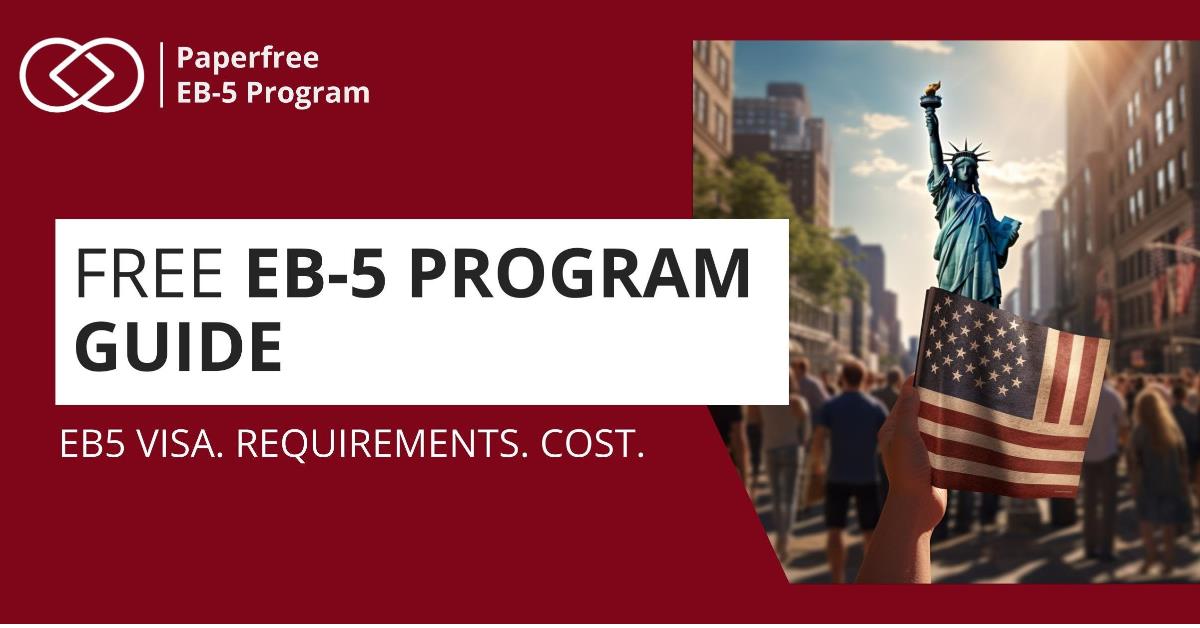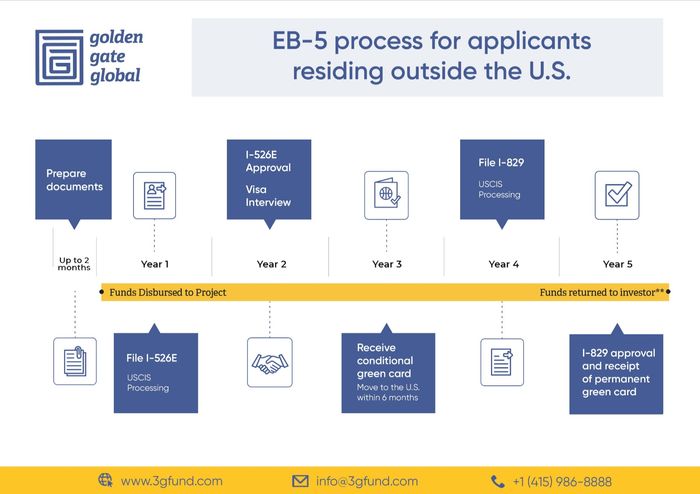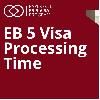EB5 visa, An easy and complete guide to getting your Green Card through EB 5 Investment Program
The EB-5 visa allows you to use your investment capital to gain permanent residency (Green Card) in the United States for you and your immediate family. Read about all the details provided by Paperfree.com.last updated Monday, December 22, 2025
#eb5 visa #EB-5 visa
| | by Sidra Jabeen | Content Manager, Paperfree Magazine |

QUICK LINKS
AD
Get Access to EB 5 Investment Visa Resources
EB-5 Visa Guide 2025: Key Points
- The EB-5 visa requires a minimum investment of $1.05 million, or $800,000 in a Targeted Employment Area (TEA).
- Investors must create at least 10 full-time jobs for U.S. workers.
- The process involves submitting Form I-526, applying for a green card, and then removing conditions after two years using Form I-829.
- Investors must demonstrate the lawful source of their funds and invest in a new commercial enterprise.
- Processing typically takes 18-24 months for the initial petition, with total processing taking 3-4 years.
- The total cost for filing fees ranges from $4,000 to $4,900.
- Benefits include permanent residency for the investor, spouse, and children, with a pathway to U.S. citizenship.
- Disadvantages include high investment requirements, risks, and a lengthy application process.
What is an EB5 visa?
The employment-based, 5th preference (EB-5) investor visa is an immigration designation that grants permanent resident status to immigrant investors. Once approved, applicants can use this visa to obtain a permanent resident green card for themselves, their spouse, and unmarried children under 21.
The U.S. Citizenship and Immigration Services (USCIS) Immigrant Program Office (IPO) has administered the EB-5 Visa program since 1990. From its inception, this immigrant investor program has been part of the U.S. government’s effort to boost the economy by increasing employment through foreign capital investment.
Our comprehensive and up-to-date EB 5 investor guide covers everything from initial investment requirements to the application process and job creation criteria. The EB5 green card process is complex, but with this EB-5 program guide, you can confidently move forward on your path to obtaining an EB-5 green card.
EB5 Visa Programs and Visa Categories
Immigrant investor visa categories are:
- C5. Employment creation outside a targeted area.
- T5. Employment creation in a targeted rural/high-unemployment area.
- R5. Investor Pilot Program* not in a targeted area.
- I5. Investor Pilot Program in a targeted area.
*Regional Center Pilot Program
- The Immigrant Investor Pilot Program (“Pilot Program”) was created by Section 610 of Public Law 102-395 (October 6,
1992), and was recently extended. - EB-5 requirements for an investor under the Pilot Program are essentially the same as in the essential EB-5 investor program, except the Pilot Program provides for investments affiliated with an economic unit known as a “Regional Center.” These investments allow for a less restrictive job-creation requirement based on “indirect” and “direct” jobs.
US EB5 Investment Visa Guide 2025

How long does it take to get an EB-5 Visa?
Although processing times vary, the USCIS processes 80% of the initial petitions (Form I-526) within 55.5 months [1]. After your initial petition gets approved, you must periodically check with the office for green card availability.
If you live abroad, the wait for green card approval through consular processing generally takes 4 to 6 months [2]. If you live in the U.S., it could take up to 45 months to get your green card decision [3]. You can get form-specific processing updates through the USCIS online tool [1]. In addition, the Visa Bulletin will indicate when your green card is available [4].
Learn more EB5 Processing Time: A Journey Towards Green Card 2024 | Paperfree.com
How much is the EB-5 Visa processing cost?
Depending on your filing location, an EB-5 investor visa costs between $4,000 and $4,900. The initial Form I-526 (Immigration Petition by Alien Entrepreneurs) requires a $3,675 filing fee. The consular processing fee will be an additional $345 if you are an out-of-country applicant. Your total would be $4020 before the cost of a medical exam.
If you apply within the U.S., you must pay $ 1,140 to file Form I-485 (the Application to Register Permanent Residence or Adjust Status). Your total would be $4,900 after you add the biometrics service fee.
Learn more EB 5 investment amount and total cost of EB 5 visa.
What are the EB-5 visa eligibility qualifications?
You must satisfy these two basic requirements to qualify for an EB 5 visa.
- The EB5 visa program requires you to invest in a U.S. Business while abiding by the minimum requirements of 8 CFR § 204.6. [5]
- You must intend to create or maintain a minimum of 10 full-time jobs reserved for U.S. workers.
What are the conditions concerning the capital investment?
Your capital investments must be made in a company established after November 29, 1990. If you intend to invest in a business that started before or on that date, it must be a new company due to a buyout or a completed restructuring. Alternatively, the business qualifies if your investment results in a 40% increase in overall value or the number of employees. In addition, the company must be an ongoing and for-profit commercial enterprise that falls into one of these business classifications.
- Sole proprietorship
- Corporation
- Joint Venture
- Business Trust
- Holding company
- Partnership
- Other publicly or privately owned entities
You can present the capital investment as cash, plant equipment, property, inventory, and other tangible assets for which you hold sole ownership. As of 3/15/2022, the minimum investment amount is $1,050,000 [6], including a TEA investment of $800,000 for infrastructure projects.
What are the EB-5 job creation requirements?
As stated earlier, the EB-5 job creation rules require you to invest the mandatory amount of capital in a new business that will establish full-time jobs for ten qualifying employees. However, there are stipulations for these three conditions.
- Non-Regional Center commercial enterprises.
For a new business located in a non-regional center, your capital investment must directly create full-time positions. This means the company must be the principal employer of the qualifying employees. The rule also applies to any of its solely-owned subsidiaries. - Regional Center commercial enterprises.
A new business within a regional center can directly or indirectly create full-time positions, giving you flexibility as a regional center investor. For this reason, up to 90% of the job creation requirement can include indirect jobs, such as positions created by contractors. However, the indirect employment must stem from the new commercial enterprise. - Troubled businesses.
If you intend to invest in a troubled business, you can qualify based on job maintenance instead of job creation. This stipulation requires that your capital investment maintain the existing number of employees for at least two years. The USCIS considers a troubled business a commercial enterprise with at least 2 years of existence and a net loss incurred within 12 or 24 months before the priority date on Form I-526. The loss must total at least 20% of the troubled enterprise’s net worth before the loss.
What’s a qualified employee?
For EB-5 visa purposes, a qualified employee must be a United States citizen, a permanent resident, or an immigrant with U.S. work authorization. This classification includes workers with conditional residency, asylee status, refugee status, and U.S. residency due to deportation.
Immigrant investors, their spouses, their offspring, or any noncitizen with a nonimmigrant status are not classified as qualified employees. This restriction also includes anyone not authorized to work in the U.S.
What qualifies as full-time employment?
The EB-5 visa definition of full-time employment is the employment of a qualified employee by the new business for at least 35 hours per week. Full-time employment in the regional center program means employment of an eligible employee in an indirectly created position requiring a minimum of 35 working hours per week.
Seasonal, transient, temporary, and intermittent jobs do not qualify as permanent full-time jobs. The employment opportunity must last at least two years.
How to apply for an EB-5 visa?
The first step to getting an EB-5 visa is:
- Submitting Form I-526 [7] with the following proof.
- You have invested in a for-profit commercial enterprise that meets the qualifications mentioned.
- The area is a Target Employment Area (TEA) or other appropriate site.
- The new business venture will add ten new employees
- If you invest in a troubled business, you must ensure that the number of employees will not drop below pre-investment levels.
- Submitting the green card application.
After you get Form I-526 approved, you can start the green card application process, which varies according to your circumstances. If you are applying from abroad, you must go through consular processing. This step requires completing Form DS-260 (Application for Immigrant Visa and Alien Registration) and getting a medical exam [8]. Then, you must take the necessary documents to a scheduled interview at the U.S. Embassy or consulate. If you apply in the U.S., you must apply through the Adjustment of Status process. The step requires completing Form I-485 and, in most cases, attending an interview [9]. Regardless of the process, your successful completion of the application will result in your receiving a conditional green card valid for 2 years. - The last step is removing conditions.
After the two years pass, you must apply to clear the conditions from your green card by completing Form I-829 (Petition by Investor to Remove Conditions on Permanent Resident Status) [10]. You must submit this form within 90 days of the green card expiration date.
Most importantly, this application process requires you to present all documents related to the commercial enterprise's status. The documents must verify the number of employees, the business location, and the total capital invested in the industry. If you successfully have the conditions removed, USCIS will grant you legal permanent residence or an EB-5 visa. As such, you will only need to renew your green card every ten years.
The Infographic for the process of obtaining an EB5 Visa
There are two paths to obtaining an EB-5 Visa: for applicants located inside the US and for applicants outside the US.
Application Submission Within the U.S.

source: paperfree.com
Application Submission Outside of the U.S.

source: 3gfund.com
Learn more on EB-5 processing time by country in 2023, 24
Appendix 1. The Foundation of EB 5 Visa, Employment-Based Visas.
The EB-5 visa, or the Employment-Based Visa, offers a path to permanent residency in the United States for noncitizens, their spouses, and children who possess the necessary job skills, education, and/or work experience and meet the eligibility requirements.
The program grants approximately 140,000 immigrant visas annually, and it offers five employment-based immigrant visa preferences (categories) that applicants may apply for.
To employ individuals in the EB-5 visa program or non-immigrant temporary workers who require immigration to the United States based on their job skills, U.S. employers must obtain a Labor certification. The certification contains attestations by the employer, including the number of U.S. workers available to undertake the employment sought by the applicant and the potential impact of the applicant's work on the wages and working conditions of the U.S. workers in similar positions.
The Secretary of Labor is responsible for issuing labor certification.
The five employment-based immigrant visa preferences (categories) are listed below.
Learn more about the History of the EB-5 Program - An Outlook For Investors.
Permanent Worker Visas Options
| Visa | Preference | Description | Labor Cert. Required? |
| EB - 1 | First | This visa category is reserved for individuals with exceptional abilities in sciences, arts, education, business, or athletics, outstanding professors or researchers, and multinational executives or managers. | No |
| EB - 2 | Second | This preference is reserved for individuals with advanced degrees or exceptional abilities in the arts, sciences, or business. | Yes |
| EB - 3 | Third | This preference is reserved for professionals, skilled workers, and other laborers with specialized knowledge or training. | Yes |
| EB - 4 | Fourth | This preference is reserved for "special immigrants," which includes certain religious workers, employees of U.S. foreign service posts, retired employees of international organizations, noncitizen minors who are wards of courts in the United States, and other classes of noncitizens. | No |
| EB - 5 | Fifth |
This preference is reserved exclusively for business investors who invest at least $1.05 million or $800,000 (if the investment is made in a targeted employment area) in a novel commercial enterprise. The enterprise must employ at least ten full-time U.S. workers for the investment to be eligible for consideration. The EB-5 Immigrant Investor Program's investor visa category aims to promote economic growth in the United States by incentivizing foreign investment in high-potential commercial ventures. |
No |
Frequently Asked Questions (FAQs) about the EB-5 Visa:
Q: Who is eligible for EB 5 Program?
A: To be eligible for an EB-5 visa, you must invest in a new commercial enterprise in the U.S., make a minimum investment of $1.05 million or $800,000 in a TEA, and create or preserve at least 10 full-time jobs for qualifying U.S. workers within two years.
Q: How long can I stay on an EB-5 Investor visa program?
A: An EB-5 investor visa program initially grants conditional permanent residency for two years. After this period, if you meet the program requirements, you can apply to remove the conditions and obtain permanent residency.
Q: How much investment is needed for EB 5 visa programs?
A: The required investment for EB 5 visa programs is $1.05 million, or $800,000 if the investment is made in a Targeted Employment Area (TEA), which includes rural areas and areas with high unemployment.
Q: What are the benefits of an EB 5 investor visa?
A: The benefits of EB 5 investor visa include obtaining U.S. permanent residency, the ability to live and work anywhere in the U.S., eligibility to apply for U.S. citizenship after five years, and the opportunity to bring your spouse and unmarried children under 21 to the U.S.
Q: What are the disadvantages of EB-5 visa programs?
A: Disadvantages of EB 5 visa program include the high investment requirement, the risk associated with the investment, the lengthy application process, and the need to prove that the investment funds are lawfully sourced.
Q: How long does it take to get an EB5 green card?
A: Getting an EB-5 green card typically takes 18 to 24 months for the initial I-526 petition. After approval, it takes an additional 6 to 12 months to process the I-829 petition to remove conditions, bringing the total to approximately 3 to 4 years.
Q: What is the golden visa for the USA?
A: The term "golden visa" is often used to refer to the EB-5 visa program in the USA. It allows foreign investors to obtain permanent residency by making a substantial investment in a U.S. business and creating jobs for U.S. workers.
Key Takeaway
The EB5 Visa Process Timeline:
- Step 1 – Select an EB-5 project
- Step 2 – Make the investment
- Step 3 – File Form I-526E/I-526
- Step 4 – Receive a conditional Green Card
- Step 5 – Removal of conditions
- Step 6 – Become a permanent resident
- Step 7 – Apply for U.S. citizenship
How can Paperfree.com help?
As you take the bold step towards securing an EB-5 visa, Paperfree is here to help you every step of the way, serving as your advisor and support, ensuring a streamlined and successful process.
Please use our EB5 Magazine for EB-5 visa News and Insights, and our Marketplace for viable EB-5 investment projects.
Sources
- Egov.USCIS.gov https://egov.uscis.gov/processing-times/
- USCIS.gov/green card https://www.uscis.gov/green-card/green-card-processes-and-procedures/consular-processing#
- USA.gov https://www.usa.gov/adjustment-of-status
- Travel.state.gov https://travel.state.gov/content/travel/en/legal/visa-law0/visa-bulletin.html
- Cornell Law https://www.law.cornell.edu/cfr/text/8/204.6
- USCIS.gov
https://www.uscis.gov/working-in-the-united-states/permanent-workers/employment-based-immigration-fifth-preference-eb-5/about-the-eb-5-visa-classification - USCIS.gov/1-526 https://www.uscis.gov/sites/default/files/document/forms/i-526.pdf
- Eforms.state.gov/Form Finder https://eforms.state.gov/
- USCIS.gov. I-485 https://www.uscis.gov/sites/default/files/document/forms/i-485.pdf
- USCIS.gov. I-829 https://www.uscis.gov/sites/default/files/document/forms/i-829.pdf
Pages Related to #eb5 visa
- Papefree EB5 investors magazine your source for EB5 insights. EB5 News.

- Paperfree Investment Visa EB-5 Program is Your Your Clear Path to Green Card USA

- History of EB-5 Program - An Outlook For Investors

- US Immigration: Big increase in EB–5 visa fees proposed

- EB 5 Visa Requirements 2024, A Guide To on eligibility for U.S. Investment-Based Residency

- EB5 Processing Time: A Journey Towards Green Card 2026 | Paperfree.com

- July 2025 Visa Bulletin: EB-5 Investment Visa Program Shows Positive Movement

- EB-5 for Tech Entrepreneurs: Immigration Program for Startup Founders | Paperfree

Popular Page
Benefits of the EB-5 Visa Program| A Comprehensive Guide
Book a Free Complimentary Call
real estate investing Investment Visa USA Investment Magazine Private Real Estate Funds real estate funds

